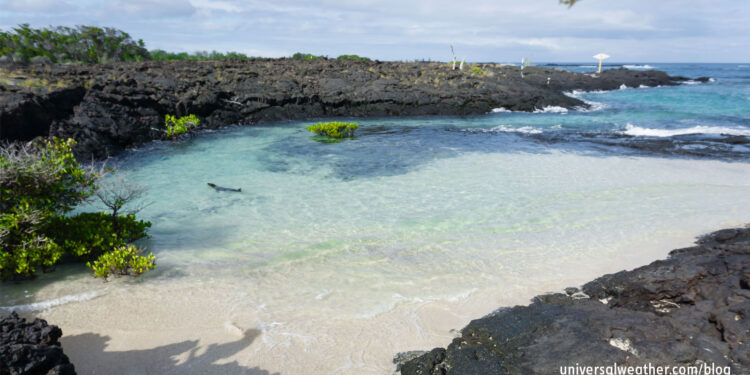Business Aircraft Operations to the Galapagos Islands – Part 1: Airport Options

This business aviation blog post is part of a series on operating to the Galapagos Islands.
The Galapagos Islands, a group of 19 islands some 620 miles west of the South American continent, are a remote and isolated region. Although there are three airports in the island group capable of General Aviation (GA) operations, each has its own restrictions with limited operating hours, aircraft parking, and service options. It’s also important to be mindful of unique Customs, Immigration, and Quarantine (CIQ) clearance procedures/requirements when planning a trip to the islands.
The following is an overview of what you need to know:
1. The Galapagos has no airports of entry
The Galapagos have three primary airports – Seymour (SEGS), General Villamil (SEII), and San Cristobal (SEST) – but none is an Airport of Entry (AOE). No overtime is possible at any of these locations, and no night-time operations are permitted. All aircraft operating to the Galapagos must first land at an AOE on the Ecuadorian mainland – Quito (SEQM) or Guayaquil (SEGU) – to clear CIQ inbound and return to an AOE on the mainland to clear outbound CIQ. Ecuador Civil Aviation Authority (CAA) will not approve international flights to/from the Galapagos under any circumstances. You’ll also need to set up airport formalities and ground handling arrangements in advance for your stop(s) in the Galapagos.
02/25/2015: Updated by author
2. Operating restrictions
Charter (non-scheduled commercial) flights are not permitted to operate to the Galapagos. Private non-revenue flights with more than 20 passengers are also prohibited from operations to the islands. Prior permission required is not needed for Galapagos operations, and the only airport requiring slots on the island chain is SEGS. There are no noise restrictions, at this time, to consider for any of the Galapagos Islands airports. There is no maintenance available at any of these airports, so it’s recommended that operators carry spare primary tires, as well as an enhanced spares kit, in the event there are issues after landing.
3. Local infrastructure
It’s important to be mindful that hotel and local transport options are very limited on the islands. Arrangements should be made several weeks in advance, particularly during high season.
4. Seymour (SEGS) airport information
SEGS is located on the island of Santa Cruz, and this airfield is only available for daylight instrument flight rules operations. GA aircraft are restricted to operations 0800-0900 and 1300-1345 local. Note that fuel and lav services are not available and cannot be arranged for this location. Due to limited ramp space and ramp construction activities, no overnight parking is currently possible at SEGS. Aircraft may, however, drop off passengers and reposition to SEST, SEGU, or SEMT for the duration of their stays. GA passengers must arrive/depart via the VIP lounge at SEGS, and there’s a fee for using this facility. Be advised that a flight dispatcher must accompany the aircraft from SEGS to the chosen reposition airport. If your aircraft is not able to accommodate a flight dispatcher, it’s the operator’s responsibility to pay the cost of having a dispatcher repositioned to the airport you’re relocating to. Airport slots, with validities of +/- 15 min, are required for all operations to SEGS, and slots can be arranged by your ground handler. Note that runway 32/14 is 7,876 feet long by 115 feet wide and has precision approach path indicator lights. The Air Traffic Control (ATC) tower frequency is 122.2. Aircraft security services are not necessary for SEGS; however, additional aircraft security can be arranged with advance notification.
5. General Villamil (SEII) airport information
SEII is available to GA 0600-1800 local. There’s no ATC tower at this location, no fire department, no runway lighting, and no fuel available. All flights to SEII should be operated during Visual Meteorological Conditions (VMC) on arrival/departure. Airport slots are not required for SEII. Only one air navigation system is available, and this operates at 246 kHz. It’s recommended that a ground handling agent be onboard to help supervise correct landing/takeoff procedures. Aircraft parking should always be confirmed before making hotel reservations. Be aware that hotel availability on all the islands is very limited. Runway 35/17 is 4,921 feet long by 98 feet wide, with an asphalt surface, high-intensity runway lights, and both centerline and touchdown lights.
6. San Cristobal (SEST) airport information
SEST is located on San Cristobal Island and has GA hours of operations 0700-0945, 1200-sunset local, seven days a week. No overtime is possible outside of normal airport hours. There’s scheduled commercial activity at this airport, and priority is given to these operations. Peak operating hours at SEST should be considered, and your 3rd-party provider will have the latest peak hour updates. Runway 35/17 is 6,036 feet long and asphalt-surfaced but somewhat rough and narrow – at 98 feet wide – with no lights. This runway has turnaround areas at each end although these are not depicted on airport charts. Note that lav services are not available at this location, and no overnight parking is possible. Three GA parking spaces are available, but you’ll only be able to park at SEST to drop off/pick up of passengers.
Conclusion
Always consider operating restrictions and aircraft service limitations, when traveling to the Galapagos. It’s recommended to carry spare primary tires, as well as an enhanced spares kit. If you have issues with the runways or maintenance, you’ll need as much backup as possible.
Questions?
If you have any questions about this article, contact me at sonnymiller@univ-wea.com.
Stay tuned for Part 2, which covers operational considerations for operations to the Galapagos Islands.




